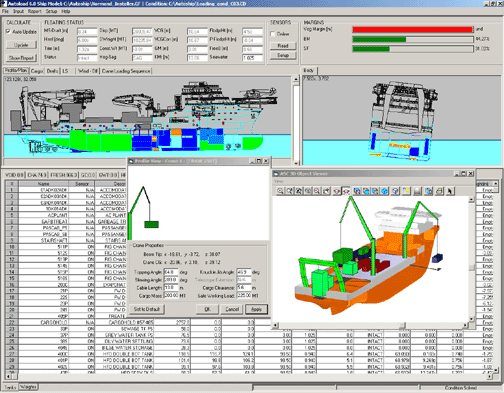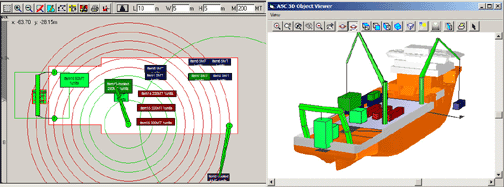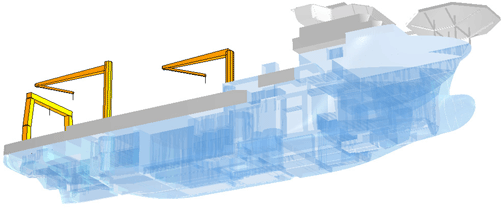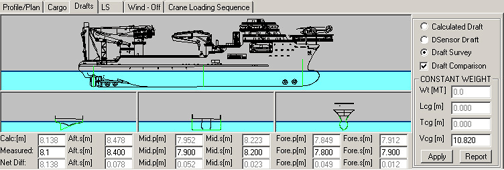Autoload 6: The New Generation Software for Offshore Vessel Loading Computers
Introduction
Offshore vessel operations are increasingly more complex. Added to this fact is the requirement to do all tasks faster and at the same time retain high safety margins. In particular, onboard cargo management including heavy crane operations requires effective tools for monitoring the vessel’s stability and strength. Fortunately, high speed computer systems are now available to assist offshore vessel crew and management to meet these operational requirements. A leader in the development of loading computer software that meets these requirements is Autoship Systems Corporation (ASC). Together with the effective system delivery process of Coastdesign Norway A/S (Coastdesign), offshore vessel companies can be assured of a reliable, turnkey solution to their loading computer requirements.
The Company
For 25 years Autoship System Corporation has developed software for the marine industry. A pioneer in CAD/CAM software for vessel design, ASC has been a world-leader in this software class throughout the company’s life.
A key software in the ASC software suite is the stability analysis program Autohydro. Autohydro is being used by more then 1000 ship design companies and yards around the world, and is accepted and approved by all governing approval bodies. In the mid-1990s, ASC decided to make a vessel-specific loading computer version of Autohydro. This new software was named Autoload.
Coastdesign Norway A/S has been a dealer of ASC software, virtually since ASC started writing programs. Coastdesign has developed a fast, reliable production and delivery system for Autoload to offshore vessels.
Autoload
At the time the early versions of Autoload were being introduced to the market, computers were just becoming strong enough to handle 3D based “first principle” stability systems onboard. Since those early days, 3D based systems have become the loading software of choice, gradually replacing the more traditional, simple table-based “loading computers”. Over this same period, Autoload has undergone constant improvement. Many of the improvements have been a result of end-user feedback The development of the highly advanced Autoload 3D based user interface has also benefited from ASC’s long experience with developing CAD/CAM software.
From the start, Autoship System Corporation has adopted a simple yet sophisticated philosophy for developing Autoload: the program must be simple to use, yet apply the most accurate mathematical analyses to all calculations. Therefore, one brief look at the Autoload screen provides the user with a quick and accurate picture of the vessel’s current stability status, loads and important margins. The user can then make critical decisions, while leaving the 3D model based mathematical complexity of the problem to the computer.
Today, this development philosophy has been maintained in the recent release of the new generation of Autoload, Autoload 6. One of the advanced yet simple to use new features in Autoload 6 is a cargo and crane handling module.
Autoload‘s cargo handling capability was first developed in response to a large cargo vessel fleet’s (Wallenius Wilhelmsen) cargo planning requirements. This particular version of Autoload includes a direct interface with the company’s booking system, advanced stowing, port rotation, cargo tracking, etc – basically everything that is important for ship planning. The Autoload 6 cargo and crane handling module is a compressed and easy to use version, developed for the offshore vessel market.

Autoload 6 screen layout with cargo module, as installed onboard Ulstein BN 271, “Normand Installer”, owned by Solstad Shipping. The main screen shows all the important parameters, including alarms. In the upper-right of the screen, the most important margins: to max allowable VCG, bending moment and shear force, are shown as green bars when within limits, changing to red when limits are exceeded. All graphical windows can be edited directly on screen. Release the mouse button and all images automatically update with the correct floating position and margins.
The Autoload 6 Cargo / Crane Module
The Autoload 6 cargo and crane module was developed for vessels where deck cargo and crane lifts are critical for the vessel’s stability. Thanks in a large part to the ASC CAD software development, the cargo and crane handling module has a very powerful 3D graphical interface for cargo editing and visualization. The newly developed graphical user interface permits the operator to edit the deck cargo and carry out crane operations in 2D and 3D graphical interfaces. The crane geometry and capacity, and cargo deck(s) are hard-coded in the 3D vessel model. Any movement of cargo or crane(s) updates the vessel’s floating position and stability margins each time the mouse button is released. Even the weight of the crane boom itself is taken into account when moving the crane.
The operation is simple. The operator can simply drag and drop cargo onto the deck, drag the cargo inside the crane’s operational range, left click the crane, select/hook the cargo, and move the crane with the mouse. The left mouse button controls the cranes topping and slewing angle, whereas the right button click moves/controls the knuckle jib angle (or telescope length).

2D and 3D deck/crane window. Note that the crane module gives visual indication of space conflict. In this example, there is a possible space conflict for cargo in the A-frame. Also note the capacity limitation for the crane at midship is indicated. (Capacity limitation, based on weight of hooked loads, is indicated by the green/red circles.)
The operator can create any cargo item, and place it on deck by use of a simple drag & drop process. Any cargo item placed inside a crane’s operation range can be hooked to the crane by a right click of the crane, followed by selecting the cargo. Dual lift is possible, as long as two cranes can reach the same cargo item.
The cargo deck can be printed to report, showing the deck layout, correct cargo properties, and all cargo details (cargo manifest). Standard cargo shapes like 20` and 40` containers are saved in a cargo shape library. The program user can add any new shapes to this library.
The program has numerous features which allow for safe crane operation. Once a cargo item is hooked, the crane’s operation range will be colour coded. Green means that the lift is safe, red means that the crane is overloaded. In addition, the crane graphical user interface allows the operator to check the feasibility of the crane lift. Conflicts such as clearance to ship’s side, height of cargo item versus height of boom, or clearance to any part of the vessel (or any other cargo on deck) are indicated. Finally, the operator can simulate a break in the crane cable simply by unhooking the crane load. The weight of hooked cargo will be removed, however the weight of the boom in correct position will be included in the calculation of floating status.
The crane sequence window allows the crane operation to be planned in detail, step by step. Each step will record the position of all cargo, the crane(s) position and load, and the ballast water distribution. The Autoload crane module handles crane types including telescope, knuckle jib, and A frame cranes.

Crane sequence window. Each step can be replayed, and the full sequence can be printed out in a report. Note the 2D crane window showing all details for the selected crane eg. crane position and load, cable length and cargo clearance (from bottom of hanging cargo to ship or other cargo on deck).
First Principle Calculations on the 3D Vessel Model
The vessel model, as the basis for all calculations, is truly 3D. It includes all volumes (tanks, holds, empty spaces, wind areas, etc). The 3D model allows first principle mathematical treatment. The result is a true simulation of any floating condition, including real shift of CG for slack tanks, wind heeling moment, and accurate damage simulation (loss of buoyancy method). In addition, with the vessel’s cranes and cargo decks hard-coded into the same 3D vessel model, the operator has a unique tool for exact simulation of any critical vessel operation. The Autoload 3D vessel model is exactly the same model as used for calculations in approved stability booklets.

Normand Installer 3D vessel model. The model includes hull & appendages, all tanks, all voids and engine rooms (for damage), superstructure (for wind), cargo deck(s) and cranes.
Vessel loading is a combination of input from tank sensors and manual input. Manual input includes tanks not online and manually entered (solid) loads. When tanks are online, Autoload will load the model tanks precisely in accordance with sensor reading and vessel trim and heel.
A key feature of Autoload is the draft survey. In the Draft Dialogue, the user can compare Autoload calculated drafts with “real drafts” – obtained either from manually observed drafts or from draft sensors. A “constant weight”, equal to the sum of unknown weights onboard, is determined from the difference between calculated drafts and real drafts. A draft survey report can be printed directly from the Draft Dialogue.

Autoload Draft Dialogue. Note the green draft marks on the model views are 3D representations of the real draft marks on the vessel hull. These marks correspond exactly to where the observed drafts are read. (If the operator decides to use drafts from sensors, the sensor readings are re-calculated and shown as drafts at the marks.)
Autoload Stream-lined Delivery Process
The vessel’s loading computer represents a very small yet crucial piece of the ship’s automation system. However, delivery of the loading computer is often a last minute issue for the yard as final stability data is not available until after the inclining test and the final approved stability booklet is released. It is therefore of great importance to the yard that delivery and installation of the loading computer is 100% streamlined and problem free.
Having gained invaluable experience from equipping more than 100 offshore vessels with Autoload, Coastdesign Norway A/S has developed a delivery process that meets the stringent timeline requirements of the shipyard. The process minimizes the time needed for the yard to get the Autoload system installed and integrated with the vessel’s automation system.
Central to the Autoload delivery process is the fact that the Autoload installation is 100% automatic. The operator need only start the setup from the installation CD, minimizing the need for computer skills. Even the computer’s registry and regional settings and tank/draft sensor communication parameters are correctly set up by the installation program.
The Autoload “plug and play” delivery process is possible because every ship specific Autoload with sensor interface communication software is lab tested. (When a vessel is equipped with the Rolls Royce (Umas) automation system, Autoload is already integrated into the Umas system delivery.) For added convenience, the installation CD for each vessel, including documentation and approval reports is now available for the shipyard and the ship owner on a password protected FTP site.
It is worth noting that for a specific vessel, the Autoload software license allows the software to be installed on an unlimited number of computers onboard and in the owner’s/operator’s office. This fact adds great flexibility to the program user, as loading condition files (a few kb) can be easily exchanged by mail between ship and office.
Autoload‘s 3D model based calculations, simple yet effective user interface, and superior cargo handling capability makes Autoload a superior loading computer software. Combined with a proven delivery process, the Autoload system is truly a software package that you should seriously consider for your next loading software requirement.
